Internship Report: Employee Dissatisfaction at Vatra Corporation
VerifiedAdded on 2022/09/03
|12
|2127
|53
Report
AI Summary
This report analyzes employee dissatisfaction at Vatra, a Ukrainian lighting equipment manufacturer, exploring the factors that contribute to it. The report begins with an introduction to employee satisfaction and its importance, followed by a discussion of factors causing dissatisfaction, including a questionnaire designed to identify these factors within Vatra. It then assesses Vatra's organizational approach, classifying it as bureaucratic, and examines the company's managerial control systems, including preliminary, screening, and post-action controls. The report highlights monotonous operations as a key problem affecting employee satisfaction and productivity, offering strategies to address this, such as job enlargement and employee involvement. The conclusion summarizes the findings, emphasizing the importance of adaptive organizational approaches and employee engagement, and recommends improvements to enhance employee satisfaction and overall organizational performance.
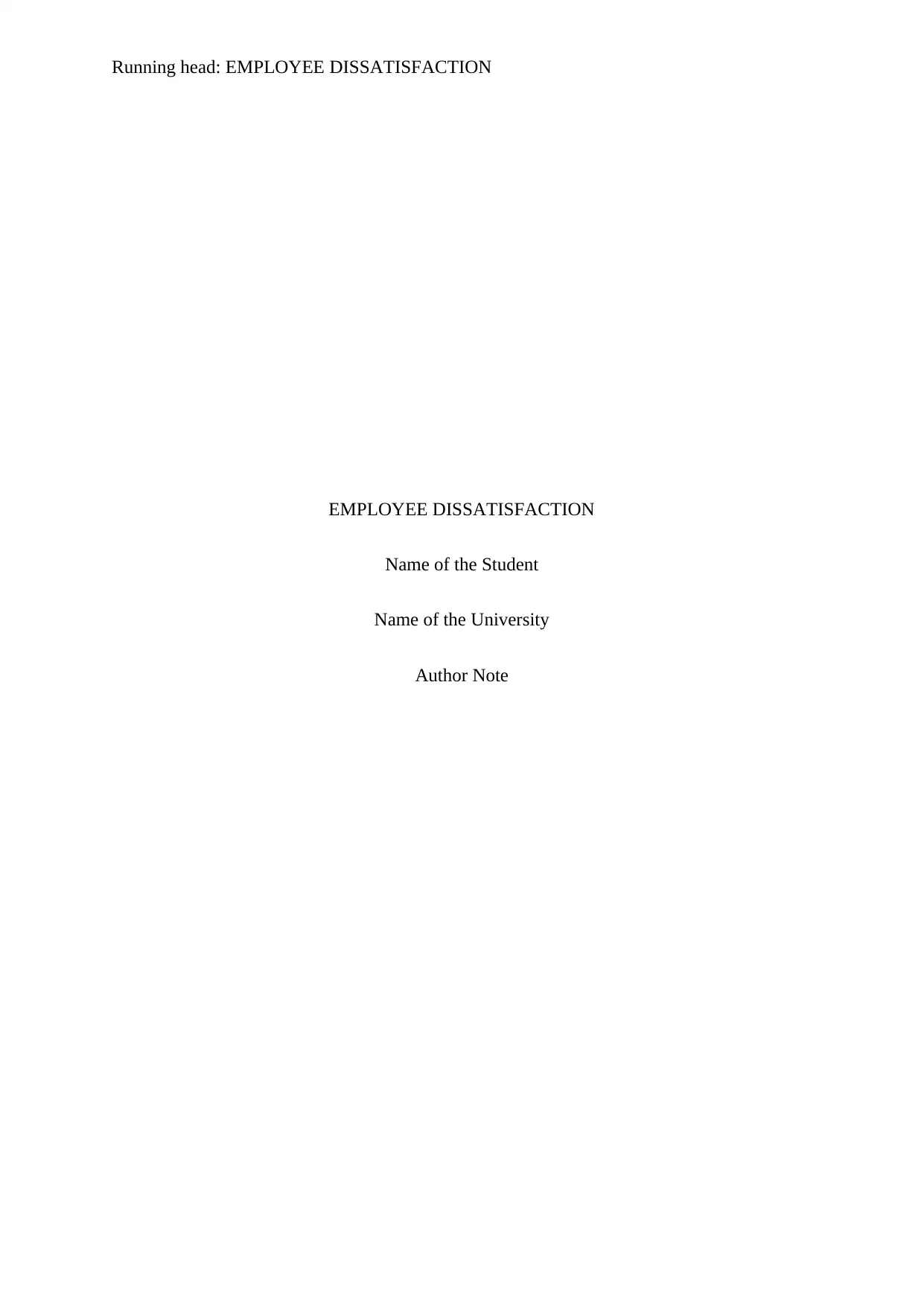
Running head: EMPLOYEE DISSATISFACTION
EMPLOYEE DISSATISFACTION
Name of the Student
Name of the University
Author Note
EMPLOYEE DISSATISFACTION
Name of the Student
Name of the University
Author Note
Paraphrase This Document
Need a fresh take? Get an instant paraphrase of this document with our AI Paraphraser
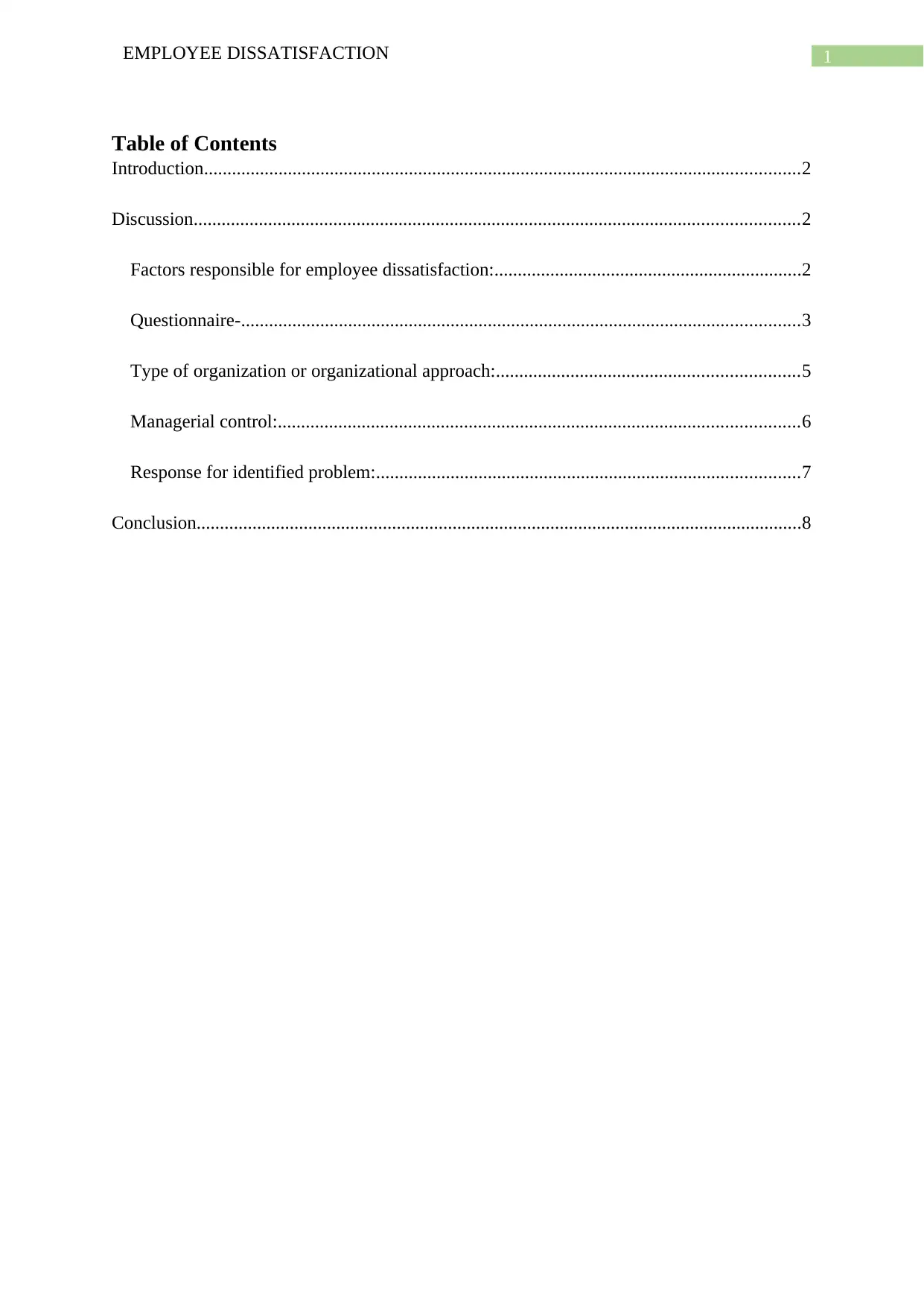
1EMPLOYEE DISSATISFACTION
Table of Contents
Introduction................................................................................................................................2
Discussion..................................................................................................................................2
Factors responsible for employee dissatisfaction:..................................................................2
Questionnaire-........................................................................................................................3
Type of organization or organizational approach:.................................................................5
Managerial control:................................................................................................................6
Response for identified problem:...........................................................................................7
Conclusion..................................................................................................................................8
Table of Contents
Introduction................................................................................................................................2
Discussion..................................................................................................................................2
Factors responsible for employee dissatisfaction:..................................................................2
Questionnaire-........................................................................................................................3
Type of organization or organizational approach:.................................................................5
Managerial control:................................................................................................................6
Response for identified problem:...........................................................................................7
Conclusion..................................................................................................................................8
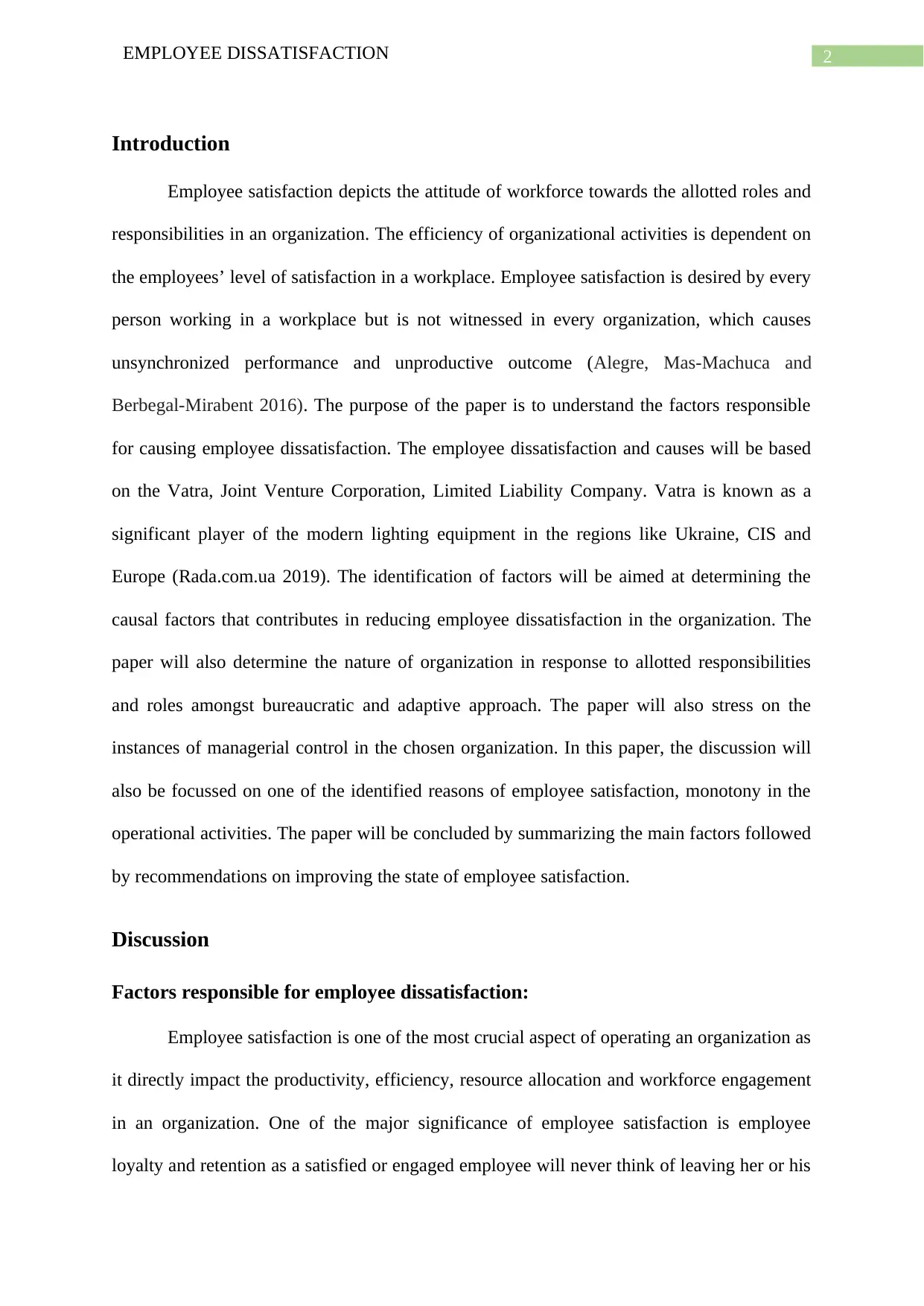
2EMPLOYEE DISSATISFACTION
Introduction
Employee satisfaction depicts the attitude of workforce towards the allotted roles and
responsibilities in an organization. The efficiency of organizational activities is dependent on
the employees’ level of satisfaction in a workplace. Employee satisfaction is desired by every
person working in a workplace but is not witnessed in every organization, which causes
unsynchronized performance and unproductive outcome (Alegre, Mas-Machuca and
Berbegal-Mirabent 2016). The purpose of the paper is to understand the factors responsible
for causing employee dissatisfaction. The employee dissatisfaction and causes will be based
on the Vatra, Joint Venture Corporation, Limited Liability Company. Vatra is known as a
significant player of the modern lighting equipment in the regions like Ukraine, CIS and
Europe (Rada.com.ua 2019). The identification of factors will be aimed at determining the
causal factors that contributes in reducing employee dissatisfaction in the organization. The
paper will also determine the nature of organization in response to allotted responsibilities
and roles amongst bureaucratic and adaptive approach. The paper will also stress on the
instances of managerial control in the chosen organization. In this paper, the discussion will
also be focussed on one of the identified reasons of employee satisfaction, monotony in the
operational activities. The paper will be concluded by summarizing the main factors followed
by recommendations on improving the state of employee satisfaction.
Discussion
Factors responsible for employee dissatisfaction:
Employee satisfaction is one of the most crucial aspect of operating an organization as
it directly impact the productivity, efficiency, resource allocation and workforce engagement
in an organization. One of the major significance of employee satisfaction is employee
loyalty and retention as a satisfied or engaged employee will never think of leaving her or his
Introduction
Employee satisfaction depicts the attitude of workforce towards the allotted roles and
responsibilities in an organization. The efficiency of organizational activities is dependent on
the employees’ level of satisfaction in a workplace. Employee satisfaction is desired by every
person working in a workplace but is not witnessed in every organization, which causes
unsynchronized performance and unproductive outcome (Alegre, Mas-Machuca and
Berbegal-Mirabent 2016). The purpose of the paper is to understand the factors responsible
for causing employee dissatisfaction. The employee dissatisfaction and causes will be based
on the Vatra, Joint Venture Corporation, Limited Liability Company. Vatra is known as a
significant player of the modern lighting equipment in the regions like Ukraine, CIS and
Europe (Rada.com.ua 2019). The identification of factors will be aimed at determining the
causal factors that contributes in reducing employee dissatisfaction in the organization. The
paper will also determine the nature of organization in response to allotted responsibilities
and roles amongst bureaucratic and adaptive approach. The paper will also stress on the
instances of managerial control in the chosen organization. In this paper, the discussion will
also be focussed on one of the identified reasons of employee satisfaction, monotony in the
operational activities. The paper will be concluded by summarizing the main factors followed
by recommendations on improving the state of employee satisfaction.
Discussion
Factors responsible for employee dissatisfaction:
Employee satisfaction is one of the most crucial aspect of operating an organization as
it directly impact the productivity, efficiency, resource allocation and workforce engagement
in an organization. One of the major significance of employee satisfaction is employee
loyalty and retention as a satisfied or engaged employee will never think of leaving her or his
⊘ This is a preview!⊘
Do you want full access?
Subscribe today to unlock all pages.

Trusted by 1+ million students worldwide
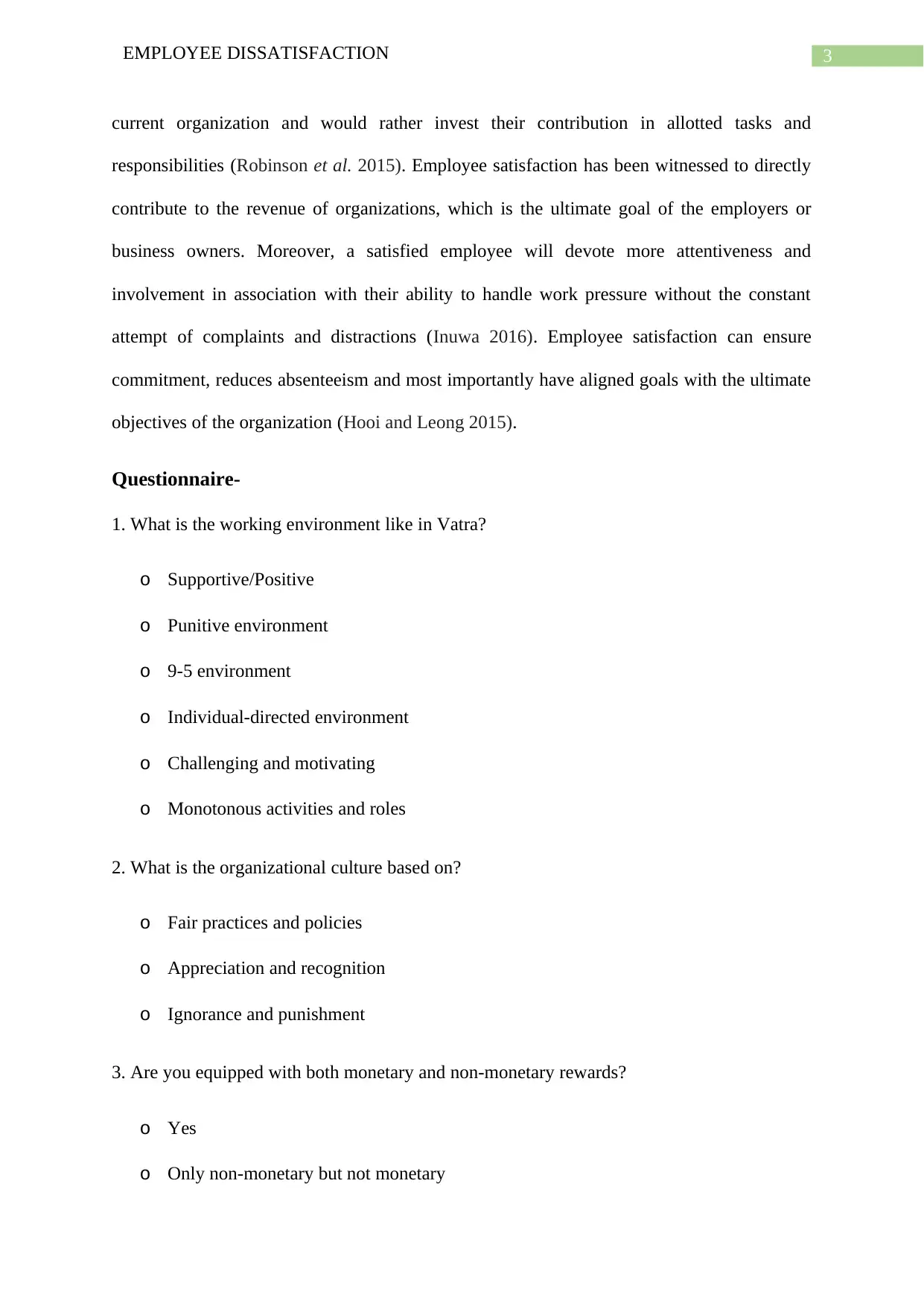
3EMPLOYEE DISSATISFACTION
current organization and would rather invest their contribution in allotted tasks and
responsibilities (Robinson et al. 2015). Employee satisfaction has been witnessed to directly
contribute to the revenue of organizations, which is the ultimate goal of the employers or
business owners. Moreover, a satisfied employee will devote more attentiveness and
involvement in association with their ability to handle work pressure without the constant
attempt of complaints and distractions (Inuwa 2016). Employee satisfaction can ensure
commitment, reduces absenteeism and most importantly have aligned goals with the ultimate
objectives of the organization (Hooi and Leong 2015).
Questionnaire-
1. What is the working environment like in Vatra?
o Supportive/Positive
o Punitive environment
o 9-5 environment
o Individual-directed environment
o Challenging and motivating
o Monotonous activities and roles
2. What is the organizational culture based on?
o Fair practices and policies
o Appreciation and recognition
o Ignorance and punishment
3. Are you equipped with both monetary and non-monetary rewards?
o Yes
o Only non-monetary but not monetary
current organization and would rather invest their contribution in allotted tasks and
responsibilities (Robinson et al. 2015). Employee satisfaction has been witnessed to directly
contribute to the revenue of organizations, which is the ultimate goal of the employers or
business owners. Moreover, a satisfied employee will devote more attentiveness and
involvement in association with their ability to handle work pressure without the constant
attempt of complaints and distractions (Inuwa 2016). Employee satisfaction can ensure
commitment, reduces absenteeism and most importantly have aligned goals with the ultimate
objectives of the organization (Hooi and Leong 2015).
Questionnaire-
1. What is the working environment like in Vatra?
o Supportive/Positive
o Punitive environment
o 9-5 environment
o Individual-directed environment
o Challenging and motivating
o Monotonous activities and roles
2. What is the organizational culture based on?
o Fair practices and policies
o Appreciation and recognition
o Ignorance and punishment
3. Are you equipped with both monetary and non-monetary rewards?
o Yes
o Only non-monetary but not monetary
Paraphrase This Document
Need a fresh take? Get an instant paraphrase of this document with our AI Paraphraser
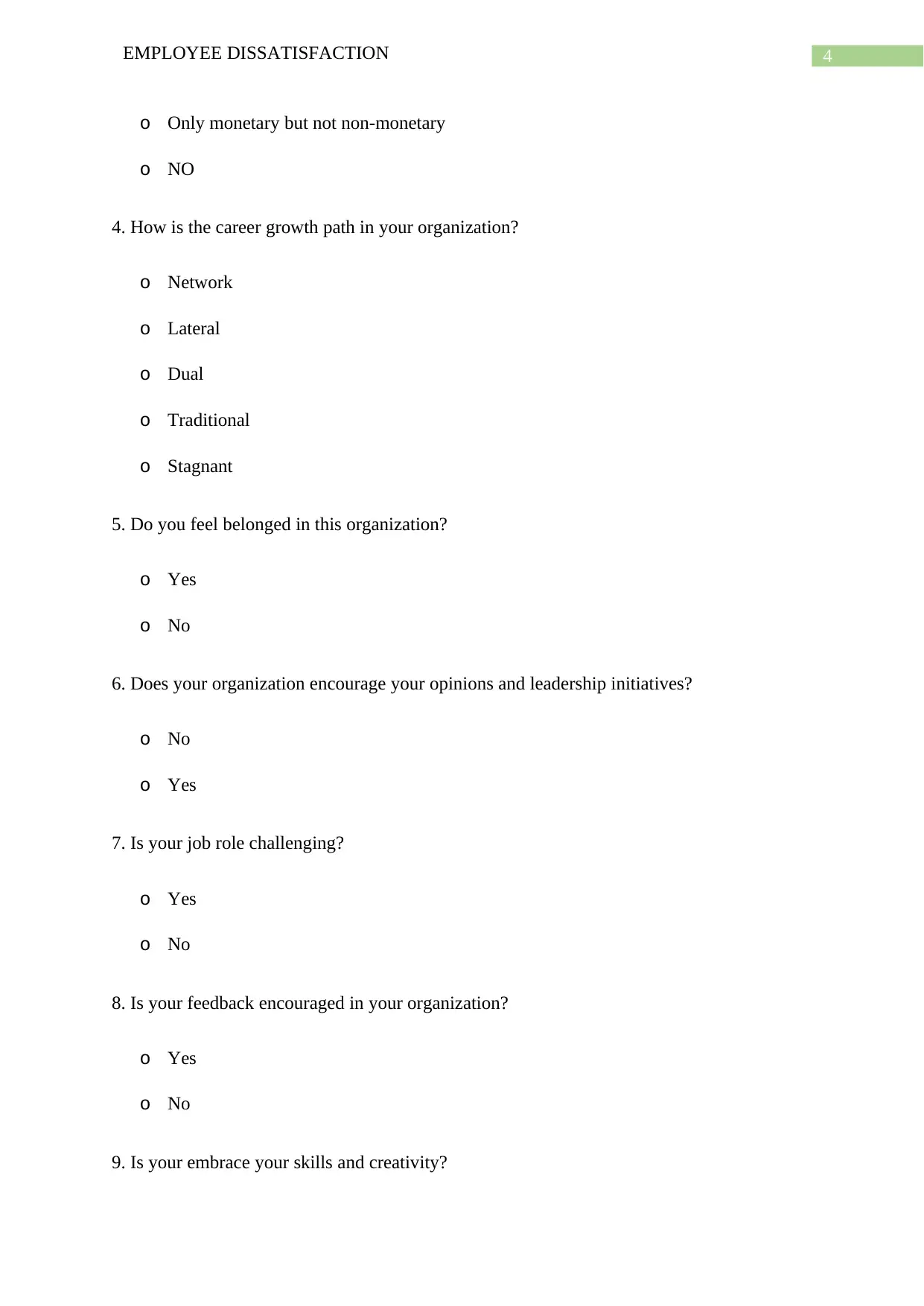
4EMPLOYEE DISSATISFACTION
o Only monetary but not non-monetary
o NO
4. How is the career growth path in your organization?
o Network
o Lateral
o Dual
o Traditional
o Stagnant
5. Do you feel belonged in this organization?
o Yes
o No
6. Does your organization encourage your opinions and leadership initiatives?
o No
o Yes
7. Is your job role challenging?
o Yes
o No
8. Is your feedback encouraged in your organization?
o Yes
o No
9. Is your embrace your skills and creativity?
o Only monetary but not non-monetary
o NO
4. How is the career growth path in your organization?
o Network
o Lateral
o Dual
o Traditional
o Stagnant
5. Do you feel belonged in this organization?
o Yes
o No
6. Does your organization encourage your opinions and leadership initiatives?
o No
o Yes
7. Is your job role challenging?
o Yes
o No
8. Is your feedback encouraged in your organization?
o Yes
o No
9. Is your embrace your skills and creativity?
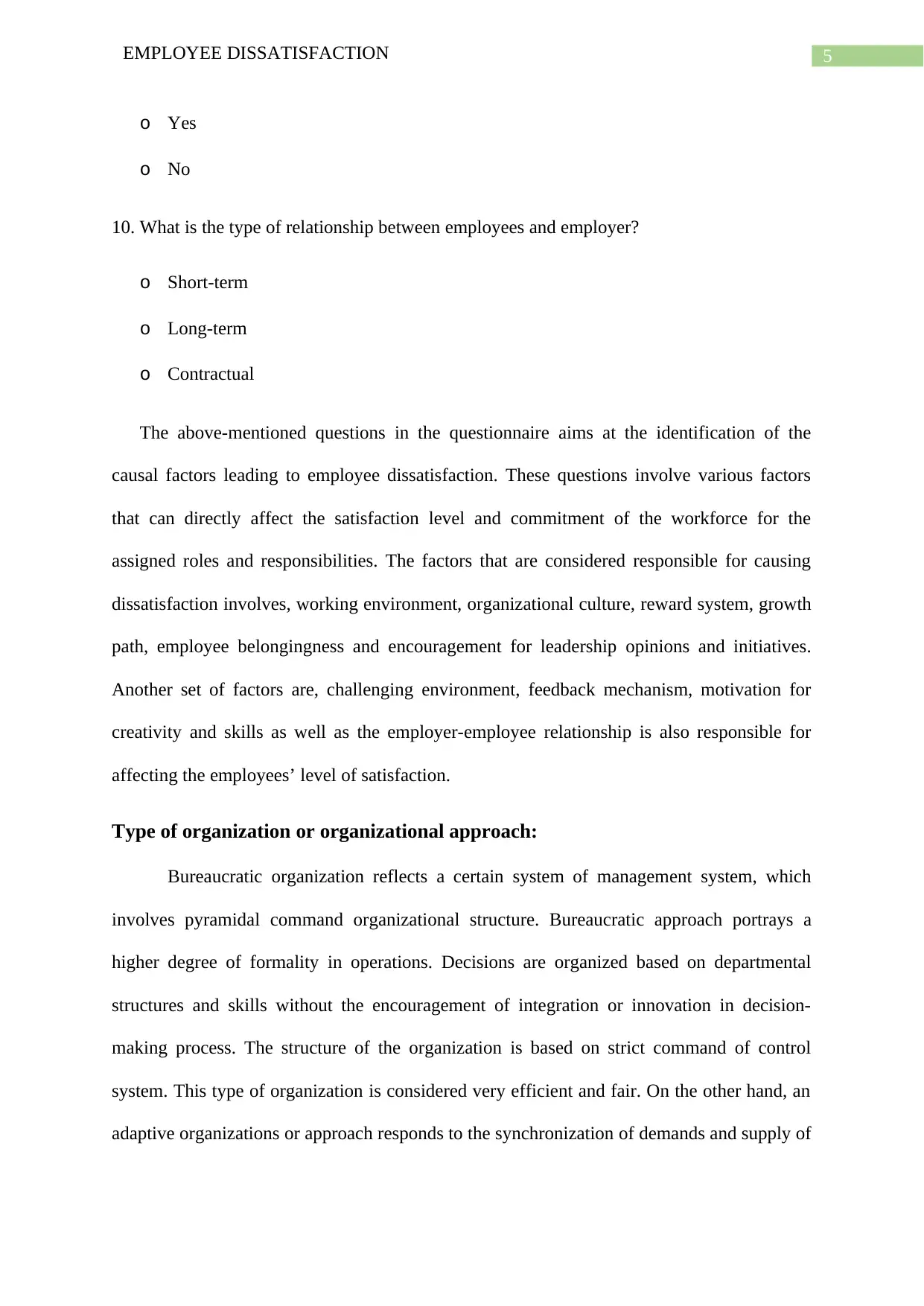
5EMPLOYEE DISSATISFACTION
o Yes
o No
10. What is the type of relationship between employees and employer?
o Short-term
o Long-term
o Contractual
The above-mentioned questions in the questionnaire aims at the identification of the
causal factors leading to employee dissatisfaction. These questions involve various factors
that can directly affect the satisfaction level and commitment of the workforce for the
assigned roles and responsibilities. The factors that are considered responsible for causing
dissatisfaction involves, working environment, organizational culture, reward system, growth
path, employee belongingness and encouragement for leadership opinions and initiatives.
Another set of factors are, challenging environment, feedback mechanism, motivation for
creativity and skills as well as the employer-employee relationship is also responsible for
affecting the employees’ level of satisfaction.
Type of organization or organizational approach:
Bureaucratic organization reflects a certain system of management system, which
involves pyramidal command organizational structure. Bureaucratic approach portrays a
higher degree of formality in operations. Decisions are organized based on departmental
structures and skills without the encouragement of integration or innovation in decision-
making process. The structure of the organization is based on strict command of control
system. This type of organization is considered very efficient and fair. On the other hand, an
adaptive organizations or approach responds to the synchronization of demands and supply of
o Yes
o No
10. What is the type of relationship between employees and employer?
o Short-term
o Long-term
o Contractual
The above-mentioned questions in the questionnaire aims at the identification of the
causal factors leading to employee dissatisfaction. These questions involve various factors
that can directly affect the satisfaction level and commitment of the workforce for the
assigned roles and responsibilities. The factors that are considered responsible for causing
dissatisfaction involves, working environment, organizational culture, reward system, growth
path, employee belongingness and encouragement for leadership opinions and initiatives.
Another set of factors are, challenging environment, feedback mechanism, motivation for
creativity and skills as well as the employer-employee relationship is also responsible for
affecting the employees’ level of satisfaction.
Type of organization or organizational approach:
Bureaucratic organization reflects a certain system of management system, which
involves pyramidal command organizational structure. Bureaucratic approach portrays a
higher degree of formality in operations. Decisions are organized based on departmental
structures and skills without the encouragement of integration or innovation in decision-
making process. The structure of the organization is based on strict command of control
system. This type of organization is considered very efficient and fair. On the other hand, an
adaptive organizations or approach responds to the synchronization of demands and supply of
⊘ This is a preview!⊘
Do you want full access?
Subscribe today to unlock all pages.

Trusted by 1+ million students worldwide
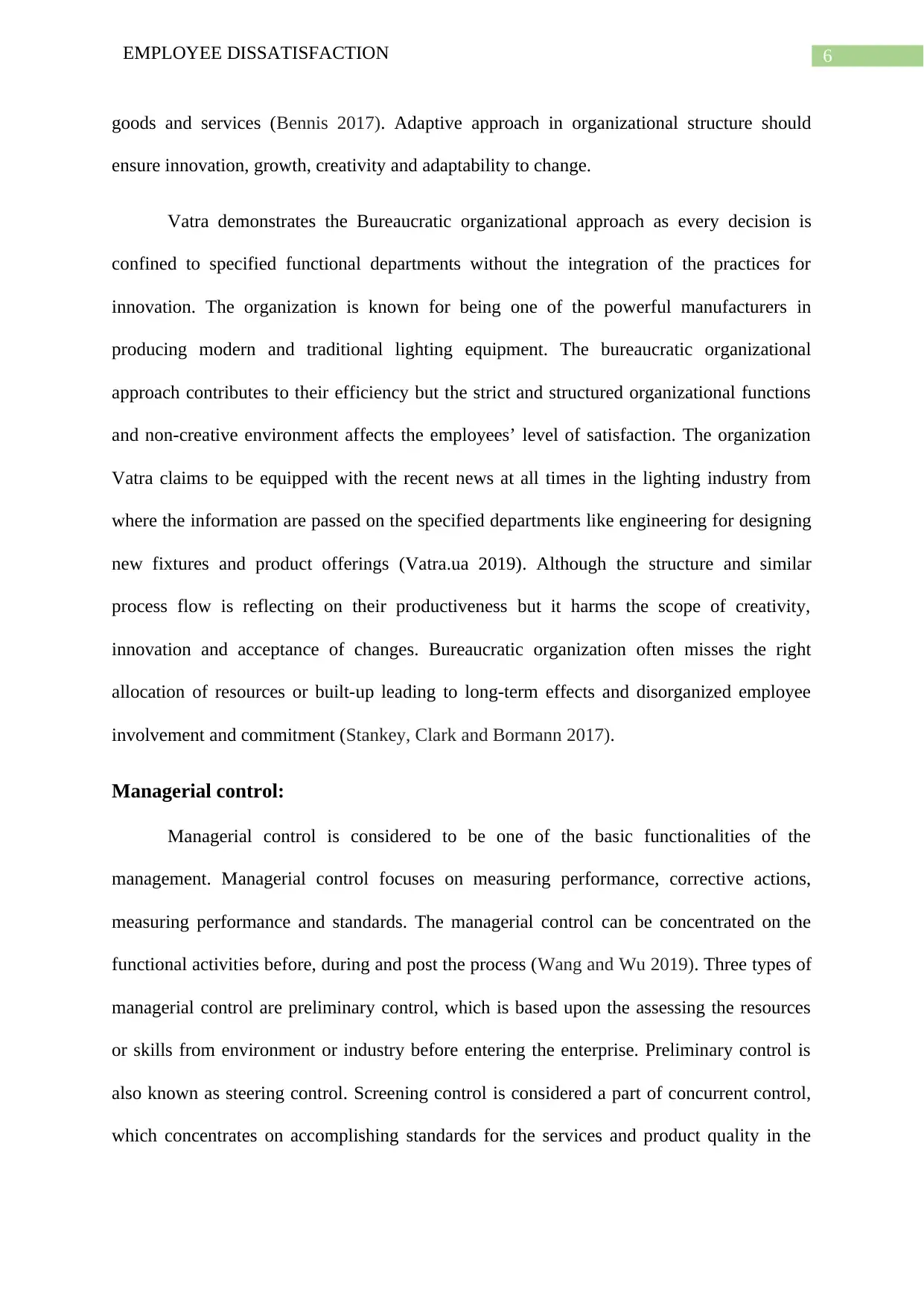
6EMPLOYEE DISSATISFACTION
goods and services (Bennis 2017). Adaptive approach in organizational structure should
ensure innovation, growth, creativity and adaptability to change.
Vatra demonstrates the Bureaucratic organizational approach as every decision is
confined to specified functional departments without the integration of the practices for
innovation. The organization is known for being one of the powerful manufacturers in
producing modern and traditional lighting equipment. The bureaucratic organizational
approach contributes to their efficiency but the strict and structured organizational functions
and non-creative environment affects the employees’ level of satisfaction. The organization
Vatra claims to be equipped with the recent news at all times in the lighting industry from
where the information are passed on the specified departments like engineering for designing
new fixtures and product offerings (Vatra.ua 2019). Although the structure and similar
process flow is reflecting on their productiveness but it harms the scope of creativity,
innovation and acceptance of changes. Bureaucratic organization often misses the right
allocation of resources or built-up leading to long-term effects and disorganized employee
involvement and commitment (Stankey, Clark and Bormann 2017).
Managerial control:
Managerial control is considered to be one of the basic functionalities of the
management. Managerial control focuses on measuring performance, corrective actions,
measuring performance and standards. The managerial control can be concentrated on the
functional activities before, during and post the process (Wang and Wu 2019). Three types of
managerial control are preliminary control, which is based upon the assessing the resources
or skills from environment or industry before entering the enterprise. Preliminary control is
also known as steering control. Screening control is considered a part of concurrent control,
which concentrates on accomplishing standards for the services and product quality in the
goods and services (Bennis 2017). Adaptive approach in organizational structure should
ensure innovation, growth, creativity and adaptability to change.
Vatra demonstrates the Bureaucratic organizational approach as every decision is
confined to specified functional departments without the integration of the practices for
innovation. The organization is known for being one of the powerful manufacturers in
producing modern and traditional lighting equipment. The bureaucratic organizational
approach contributes to their efficiency but the strict and structured organizational functions
and non-creative environment affects the employees’ level of satisfaction. The organization
Vatra claims to be equipped with the recent news at all times in the lighting industry from
where the information are passed on the specified departments like engineering for designing
new fixtures and product offerings (Vatra.ua 2019). Although the structure and similar
process flow is reflecting on their productiveness but it harms the scope of creativity,
innovation and acceptance of changes. Bureaucratic organization often misses the right
allocation of resources or built-up leading to long-term effects and disorganized employee
involvement and commitment (Stankey, Clark and Bormann 2017).
Managerial control:
Managerial control is considered to be one of the basic functionalities of the
management. Managerial control focuses on measuring performance, corrective actions,
measuring performance and standards. The managerial control can be concentrated on the
functional activities before, during and post the process (Wang and Wu 2019). Three types of
managerial control are preliminary control, which is based upon the assessing the resources
or skills from environment or industry before entering the enterprise. Preliminary control is
also known as steering control. Screening control is considered a part of concurrent control,
which concentrates on accomplishing standards for the services and product quality in the
Paraphrase This Document
Need a fresh take? Get an instant paraphrase of this document with our AI Paraphraser
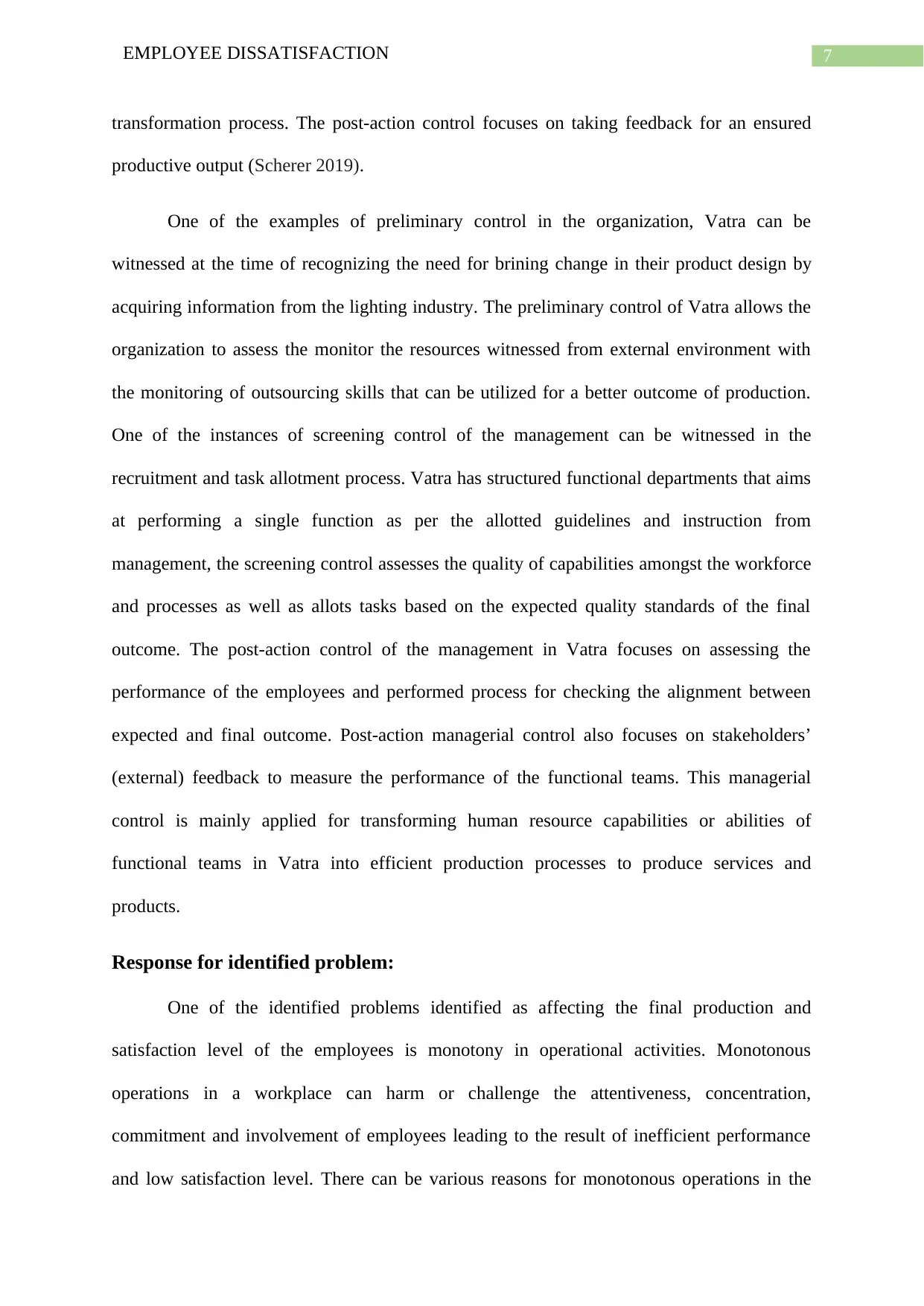
7EMPLOYEE DISSATISFACTION
transformation process. The post-action control focuses on taking feedback for an ensured
productive output (Scherer 2019).
One of the examples of preliminary control in the organization, Vatra can be
witnessed at the time of recognizing the need for brining change in their product design by
acquiring information from the lighting industry. The preliminary control of Vatra allows the
organization to assess the monitor the resources witnessed from external environment with
the monitoring of outsourcing skills that can be utilized for a better outcome of production.
One of the instances of screening control of the management can be witnessed in the
recruitment and task allotment process. Vatra has structured functional departments that aims
at performing a single function as per the allotted guidelines and instruction from
management, the screening control assesses the quality of capabilities amongst the workforce
and processes as well as allots tasks based on the expected quality standards of the final
outcome. The post-action control of the management in Vatra focuses on assessing the
performance of the employees and performed process for checking the alignment between
expected and final outcome. Post-action managerial control also focuses on stakeholders’
(external) feedback to measure the performance of the functional teams. This managerial
control is mainly applied for transforming human resource capabilities or abilities of
functional teams in Vatra into efficient production processes to produce services and
products.
Response for identified problem:
One of the identified problems identified as affecting the final production and
satisfaction level of the employees is monotony in operational activities. Monotonous
operations in a workplace can harm or challenge the attentiveness, concentration,
commitment and involvement of employees leading to the result of inefficient performance
and low satisfaction level. There can be various reasons for monotonous operations in the
transformation process. The post-action control focuses on taking feedback for an ensured
productive output (Scherer 2019).
One of the examples of preliminary control in the organization, Vatra can be
witnessed at the time of recognizing the need for brining change in their product design by
acquiring information from the lighting industry. The preliminary control of Vatra allows the
organization to assess the monitor the resources witnessed from external environment with
the monitoring of outsourcing skills that can be utilized for a better outcome of production.
One of the instances of screening control of the management can be witnessed in the
recruitment and task allotment process. Vatra has structured functional departments that aims
at performing a single function as per the allotted guidelines and instruction from
management, the screening control assesses the quality of capabilities amongst the workforce
and processes as well as allots tasks based on the expected quality standards of the final
outcome. The post-action control of the management in Vatra focuses on assessing the
performance of the employees and performed process for checking the alignment between
expected and final outcome. Post-action managerial control also focuses on stakeholders’
(external) feedback to measure the performance of the functional teams. This managerial
control is mainly applied for transforming human resource capabilities or abilities of
functional teams in Vatra into efficient production processes to produce services and
products.
Response for identified problem:
One of the identified problems identified as affecting the final production and
satisfaction level of the employees is monotony in operational activities. Monotonous
operations in a workplace can harm or challenge the attentiveness, concentration,
commitment and involvement of employees leading to the result of inefficient performance
and low satisfaction level. There can be various reasons for monotonous operations in the
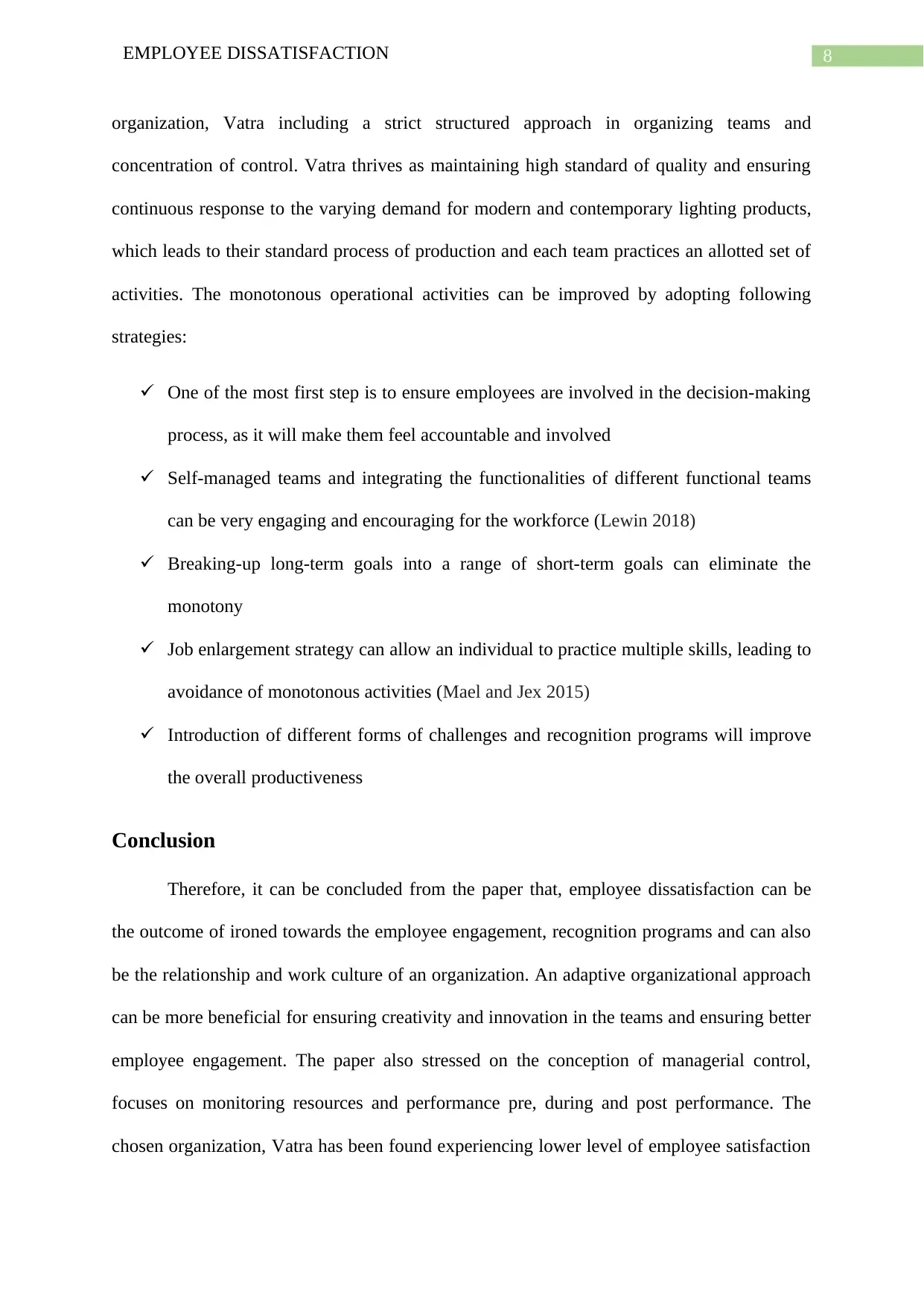
8EMPLOYEE DISSATISFACTION
organization, Vatra including a strict structured approach in organizing teams and
concentration of control. Vatra thrives as maintaining high standard of quality and ensuring
continuous response to the varying demand for modern and contemporary lighting products,
which leads to their standard process of production and each team practices an allotted set of
activities. The monotonous operational activities can be improved by adopting following
strategies:
One of the most first step is to ensure employees are involved in the decision-making
process, as it will make them feel accountable and involved
Self-managed teams and integrating the functionalities of different functional teams
can be very engaging and encouraging for the workforce (Lewin 2018)
Breaking-up long-term goals into a range of short-term goals can eliminate the
monotony
Job enlargement strategy can allow an individual to practice multiple skills, leading to
avoidance of monotonous activities (Mael and Jex 2015)
Introduction of different forms of challenges and recognition programs will improve
the overall productiveness
Conclusion
Therefore, it can be concluded from the paper that, employee dissatisfaction can be
the outcome of ironed towards the employee engagement, recognition programs and can also
be the relationship and work culture of an organization. An adaptive organizational approach
can be more beneficial for ensuring creativity and innovation in the teams and ensuring better
employee engagement. The paper also stressed on the conception of managerial control,
focuses on monitoring resources and performance pre, during and post performance. The
chosen organization, Vatra has been found experiencing lower level of employee satisfaction
organization, Vatra including a strict structured approach in organizing teams and
concentration of control. Vatra thrives as maintaining high standard of quality and ensuring
continuous response to the varying demand for modern and contemporary lighting products,
which leads to their standard process of production and each team practices an allotted set of
activities. The monotonous operational activities can be improved by adopting following
strategies:
One of the most first step is to ensure employees are involved in the decision-making
process, as it will make them feel accountable and involved
Self-managed teams and integrating the functionalities of different functional teams
can be very engaging and encouraging for the workforce (Lewin 2018)
Breaking-up long-term goals into a range of short-term goals can eliminate the
monotony
Job enlargement strategy can allow an individual to practice multiple skills, leading to
avoidance of monotonous activities (Mael and Jex 2015)
Introduction of different forms of challenges and recognition programs will improve
the overall productiveness
Conclusion
Therefore, it can be concluded from the paper that, employee dissatisfaction can be
the outcome of ironed towards the employee engagement, recognition programs and can also
be the relationship and work culture of an organization. An adaptive organizational approach
can be more beneficial for ensuring creativity and innovation in the teams and ensuring better
employee engagement. The paper also stressed on the conception of managerial control,
focuses on monitoring resources and performance pre, during and post performance. The
chosen organization, Vatra has been found experiencing lower level of employee satisfaction
⊘ This is a preview!⊘
Do you want full access?
Subscribe today to unlock all pages.

Trusted by 1+ million students worldwide
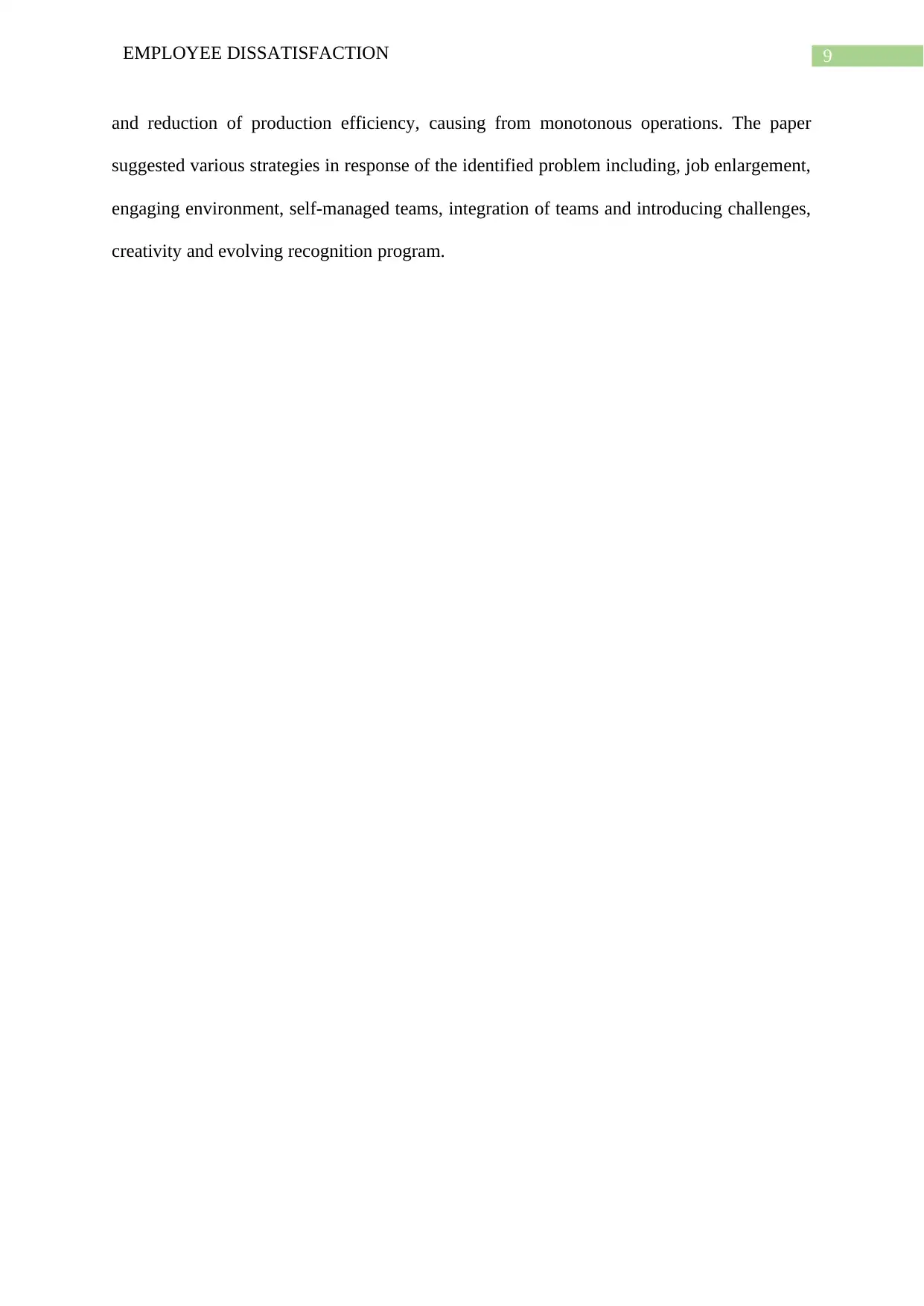
9EMPLOYEE DISSATISFACTION
and reduction of production efficiency, causing from monotonous operations. The paper
suggested various strategies in response of the identified problem including, job enlargement,
engaging environment, self-managed teams, integration of teams and introducing challenges,
creativity and evolving recognition program.
and reduction of production efficiency, causing from monotonous operations. The paper
suggested various strategies in response of the identified problem including, job enlargement,
engaging environment, self-managed teams, integration of teams and introducing challenges,
creativity and evolving recognition program.
Paraphrase This Document
Need a fresh take? Get an instant paraphrase of this document with our AI Paraphraser
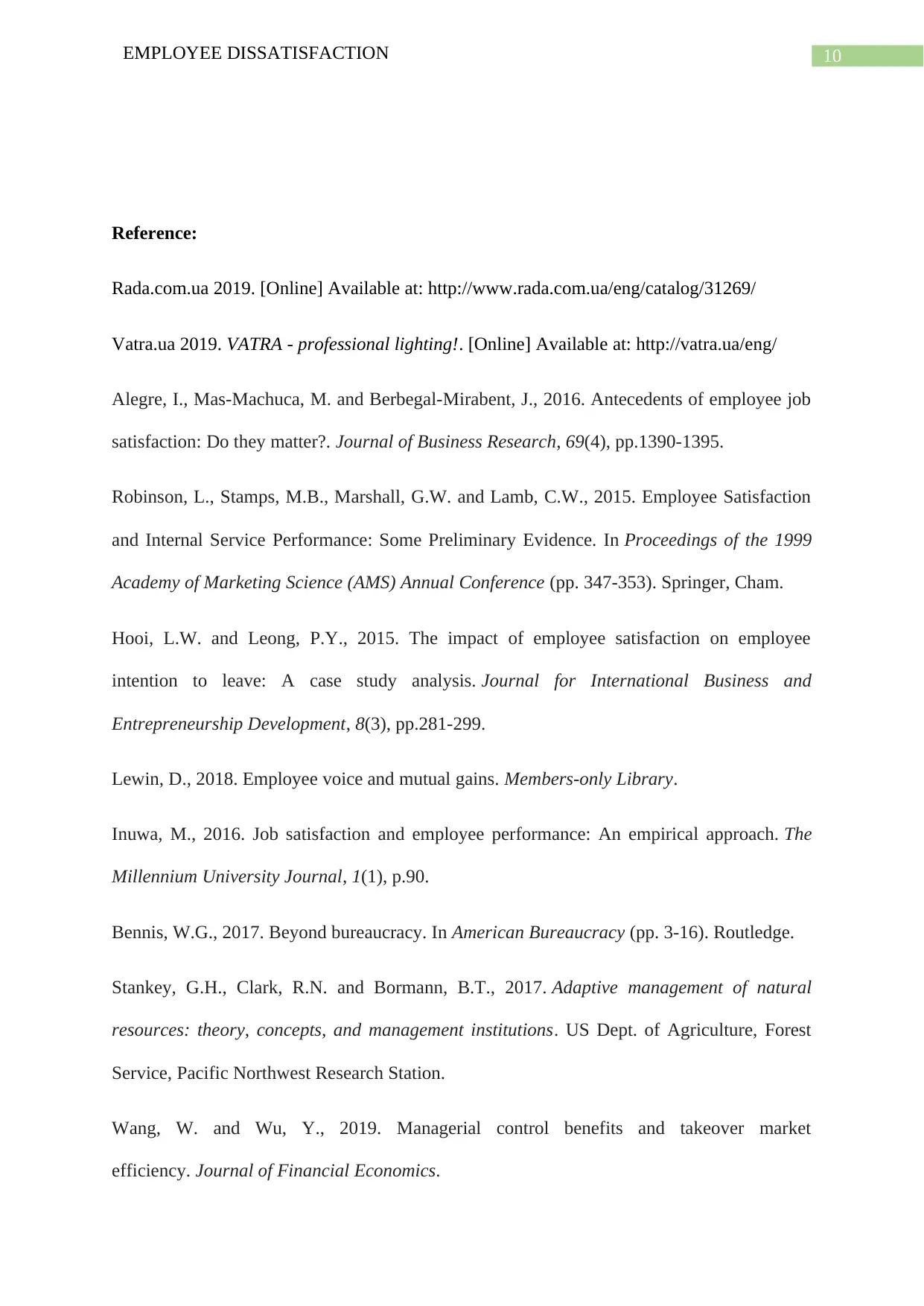
10EMPLOYEE DISSATISFACTION
Reference:
Rada.com.ua 2019. [Online] Available at: http://www.rada.com.ua/eng/catalog/31269/
Vatra.ua 2019. VATRA - professional lighting!. [Online] Available at: http://vatra.ua/eng/
Alegre, I., Mas-Machuca, M. and Berbegal-Mirabent, J., 2016. Antecedents of employee job
satisfaction: Do they matter?. Journal of Business Research, 69(4), pp.1390-1395.
Robinson, L., Stamps, M.B., Marshall, G.W. and Lamb, C.W., 2015. Employee Satisfaction
and Internal Service Performance: Some Preliminary Evidence. In Proceedings of the 1999
Academy of Marketing Science (AMS) Annual Conference (pp. 347-353). Springer, Cham.
Hooi, L.W. and Leong, P.Y., 2015. The impact of employee satisfaction on employee
intention to leave: A case study analysis. Journal for International Business and
Entrepreneurship Development, 8(3), pp.281-299.
Lewin, D., 2018. Employee voice and mutual gains. Members-only Library.
Inuwa, M., 2016. Job satisfaction and employee performance: An empirical approach. The
Millennium University Journal, 1(1), p.90.
Bennis, W.G., 2017. Beyond bureaucracy. In American Bureaucracy (pp. 3-16). Routledge.
Stankey, G.H., Clark, R.N. and Bormann, B.T., 2017. Adaptive management of natural
resources: theory, concepts, and management institutions. US Dept. of Agriculture, Forest
Service, Pacific Northwest Research Station.
Wang, W. and Wu, Y., 2019. Managerial control benefits and takeover market
efficiency. Journal of Financial Economics.
Reference:
Rada.com.ua 2019. [Online] Available at: http://www.rada.com.ua/eng/catalog/31269/
Vatra.ua 2019. VATRA - professional lighting!. [Online] Available at: http://vatra.ua/eng/
Alegre, I., Mas-Machuca, M. and Berbegal-Mirabent, J., 2016. Antecedents of employee job
satisfaction: Do they matter?. Journal of Business Research, 69(4), pp.1390-1395.
Robinson, L., Stamps, M.B., Marshall, G.W. and Lamb, C.W., 2015. Employee Satisfaction
and Internal Service Performance: Some Preliminary Evidence. In Proceedings of the 1999
Academy of Marketing Science (AMS) Annual Conference (pp. 347-353). Springer, Cham.
Hooi, L.W. and Leong, P.Y., 2015. The impact of employee satisfaction on employee
intention to leave: A case study analysis. Journal for International Business and
Entrepreneurship Development, 8(3), pp.281-299.
Lewin, D., 2018. Employee voice and mutual gains. Members-only Library.
Inuwa, M., 2016. Job satisfaction and employee performance: An empirical approach. The
Millennium University Journal, 1(1), p.90.
Bennis, W.G., 2017. Beyond bureaucracy. In American Bureaucracy (pp. 3-16). Routledge.
Stankey, G.H., Clark, R.N. and Bormann, B.T., 2017. Adaptive management of natural
resources: theory, concepts, and management institutions. US Dept. of Agriculture, Forest
Service, Pacific Northwest Research Station.
Wang, W. and Wu, Y., 2019. Managerial control benefits and takeover market
efficiency. Journal of Financial Economics.
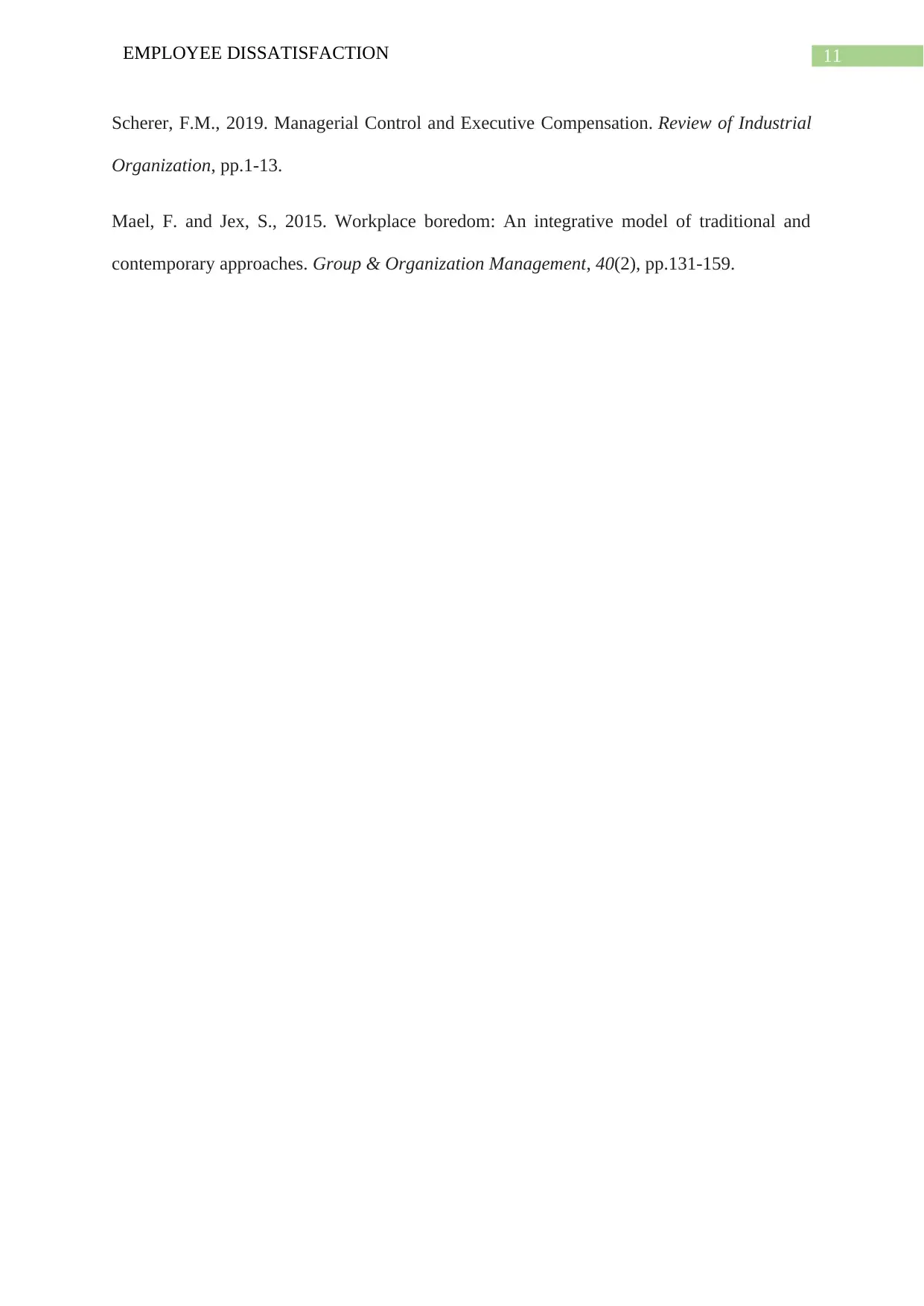
11EMPLOYEE DISSATISFACTION
Scherer, F.M., 2019. Managerial Control and Executive Compensation. Review of Industrial
Organization, pp.1-13.
Mael, F. and Jex, S., 2015. Workplace boredom: An integrative model of traditional and
contemporary approaches. Group & Organization Management, 40(2), pp.131-159.
Scherer, F.M., 2019. Managerial Control and Executive Compensation. Review of Industrial
Organization, pp.1-13.
Mael, F. and Jex, S., 2015. Workplace boredom: An integrative model of traditional and
contemporary approaches. Group & Organization Management, 40(2), pp.131-159.
⊘ This is a preview!⊘
Do you want full access?
Subscribe today to unlock all pages.

Trusted by 1+ million students worldwide
1 out of 12
Related Documents
Your All-in-One AI-Powered Toolkit for Academic Success.
+13062052269
info@desklib.com
Available 24*7 on WhatsApp / Email
![[object Object]](/_next/static/media/star-bottom.7253800d.svg)
Unlock your academic potential
Copyright © 2020–2025 A2Z Services. All Rights Reserved. Developed and managed by ZUCOL.




